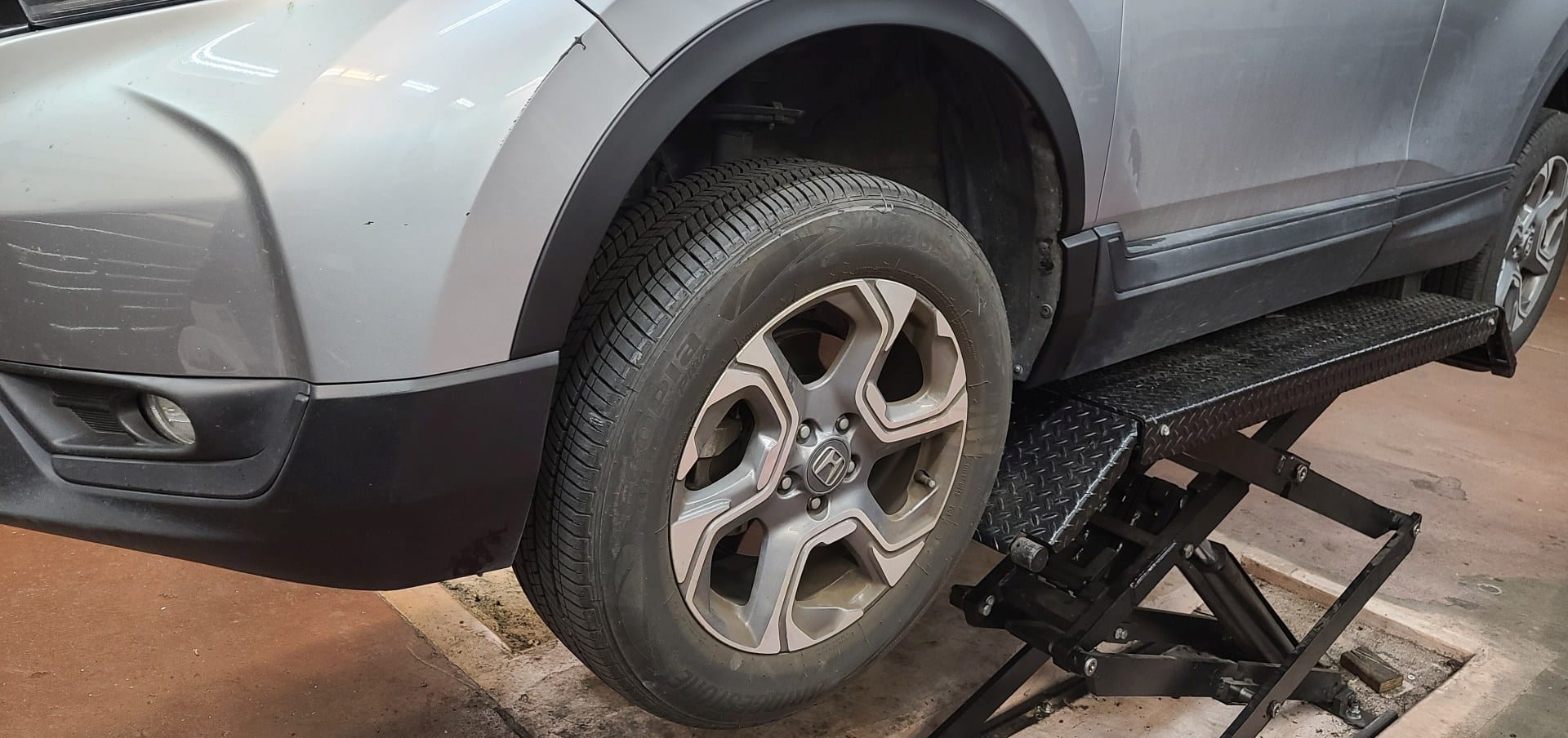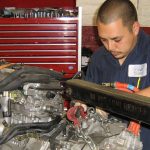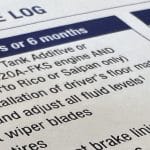If you’re in the East Bay and need a tire rotation, we’d be happy to help. We rotate thousands of sets of tires every year in our Berkeley shop, and we’ll do a good job. That said, tire rotation isn’t challenging in any way. Nearly any mechanic should be able to do this necessary maintenance properly, but you should have it done. Regular tire rotation is important to ensure even tread wear and extend tire life. This page isn’t just about getting you into our shop; it’s about helping you understand what tire rotation and balance are, how often you should do them, and the real benefits you can expect.
What Is Tire Rotation?
What is tire rotation? It’s simply changing the position of the tires on the car. For example, taking the front wheels off and putting them on the rear, then taking the rear wheels and putting them on the front.
Manufactures or car owners may prefer a different rotation patterns. Usually, tire manufacturers will publish their preferred method, which may not be the same as what your vehicle manufacturer recommends. Both may differ from the rotation pattern your mechanic wants to use. The truth is, it doesn’t make much difference which way you rotate the tires, as long as each tire spends equal time on the front and rear of the car. Some older or lower-quality tires do not perform well when rotated side to side, so if in doubt, it’s safest to rotate front to rear without crossing sides.
How often should I rotate tires?
Most mechanics recommend tire rotation somewhere between every 5,000 miles and 7,500 miles. Back when oil change intervals were 3,000 miles, we recommended rotating tires every 6,000 miles, or every other oil change. Now that most manufacturers have moved to 5,000-mile intervals, we rotate every 5,000 miles. This is primarily a matter of convenience. One visit to the shop every 4 – 6 months is plenty for most people, even those who really like us.
Why should I rotate my tires?
We recommend tire rotation because it will increase the life of the tire, prevent irregular wear, and to allow all four tires to wear out at the same time so they can be replaced with a matching set.
Front of the car develop wear pattern peculiar to the front of the car. Rear tires develop wear patterns peculiar to the rear. Front tires tend to wear on the inside edge. This is caused by scrubbing on the inside of the tire as the suspension compresses when going over bumps, and by the front wheels’ tendency to increase toe-out at freeway speeds. Hopping and skipping caused by toe causes the rear tire to develop a choppy wear pattern. Rotating the tires helps minimize each of these types of wear by minimizing the amount of time the tire spends in each position.
Tires that are on the front of a front wheel drive car wear twice as fast as tires on the rear of a car. There are four reasons for this:
- The engine’s power goes through the front tires on its way to the ground
- The front brakes (and therefore the front tires) do most of the braking
- The front tires shoulder more of the cornering load
- and the front of the car is heavier than the rear in most cases.
What would happen if I didn’t rotate my tires?
If you don’t rotate your tires a couple things will happen. Your front tires will wear out long before your rears, so you’ll need to buy two new tires when they do. You may have trouble matching the tires you have on the rear and mismatched tires aren’t ideal. Different models of tires have differing handling and traction characteristics, it’s best (but not essential) to have them match.
The other thing that frequently happens when you don’t rotate is that the rear tires will wear unevenly causing them to make a droning noise on the freeway. Sometimes the noise is so annoying that people will buy a set of 4 tires instead of just the worn out front tires. In this case they’d get about half the life out of their tires as if they had done the rotations.
Should I rotate my spare tire in?
Most cars these days have a “space-saver” spare — a spare tire that is smaller than the rest of the tires, so it fits neatly in the trunk. Even cars that have a full-size spare often use a tire that is not rated for freeway speeds, or a rim that does not match the other four. we don’t recommend rotating the spare tire in most cases.
What is tire balancing?
We balance tires by adding lead weights to a rim to cancel out any heavy areas of the tire. If the tire has a heavy spot, it will cause a vibration when it spins fast, kind of like a washing machine with an unbalanced load when the spin cycle starts. The whole car may shake when an out-of-balance tire gets up to speed. People often report this as the steering wheel shaking, or the rear-view mirror shaking. Some customers have reported their car “feels like a coin operated vibrating bed in a hotel”.
What is the difference between tire balancing and alignment?
Many people think that tire balancing and alignment are the same thing, but they’re actually completely different. Tire balancing means adding lead weights to a rim to cancel out any heavy areas of the tire. Wheel alignment is adjusting the wheels to point straight ahead (toe), not to lean to either side (camber), and to maintain stability (caster).
When should I balance my tires?
We recommend balancing the two tires leaving the rear of the car to go to the front with every rotation.
There are two reasons for this:
- Balancing all four tires with every rotation might be ‘over-servicing.’ In other words, balancing all four tires every 5,000 to 7,500 miles probably would not provide any appreciable benefit over balancing the tires every 10,000 to 15,000 miles, but it would cost twice as much.
- A rear tire that is out of balance may not cause any noticeable symptoms (such as vibration or shaking on the freeway). However, if we move that tire to the front during rotation, it may cause a very noticeable symptom.
What’s a Good Shop In Berkeley For Tire Rotation?
Art’s Automotive of course! But if you’re not close to Berkeley, pretty much any shop should be able to rotate your tires since it’s a low-skill procedure. You just need an honest shop with fair prices. If you’d like some tips on finding a good mechanic, click the link.
Other tire-related articles
- Art’s Automotive | A good tire shop in Berkeley!
- Should I Put my New Tires on the Front or Rear?
- Buying Tires
- Wheel Alignment
- Tire Balance
Our Primary Auto Repair Services & Other Collections
Below are links to some of the other automotive maintenance, repair, and diagnostic services we offer at Art’s Automotive, including a link to our services page, which is a collection of articles explaining all of the services we provide. We also have a collection of articles about our shop and how we do business and a collection of informative blog type articles we’ve written over the years.
Car Electrical Repair in Berkeley – Art’s Automotive
Art's Automotive provides fast, accurate diagnosis and repair of all types of car electrical problems. We serve Berkeley and the nearby cities Oakland, Emeryville, El Cerrito, and Richmond. Not only...
Mazda Service & Repair In Berkeley – Art’s Automotive
Art's Automotive has been servicing Mazda vehicles in Berkeley for over 40 years now. Mazda isn't our biggest brand, but they're popular in the Bay Area and they make some...
Honda service & Repair in Berkeley – Art’s Automotive
At Art’s Automotive, our goal is to keep your Honda running reliably and your costs low by providing an intelligent service plan and fairly priced repair. On this page, you’ll...
Toyota Service & Repair in Berkeley – Art’s Automotive
If you're looking for a shop in Berkeley to service your Toyota, this page will give you an idea of what to expect at our shop, and explain what we've...
Subaru Service & Repair In Berkeley – Art’s Automotive
Whether you're one of our customers in Berkeley or just someone researching the service and maintenance needs of your Subaru, we hope you'll find this article useful. It's our honest...
Car Service & Maintenance Explained | Art’s Automotive Berkeley
During our 40+ years in Berkeley, we’ve learned a lot about what car service & maintenance is critical, and what service items can be postponed relatively safely if money is...
Hybrid Service in Berkeley, East Bay | Art’s Automotive
Are you looking for hybrid or EV service, diagnosis, or repair in Berkeley? Art's Automotive is the East Bay's leading hybrid & EV specialist. On this page we'll try to...








